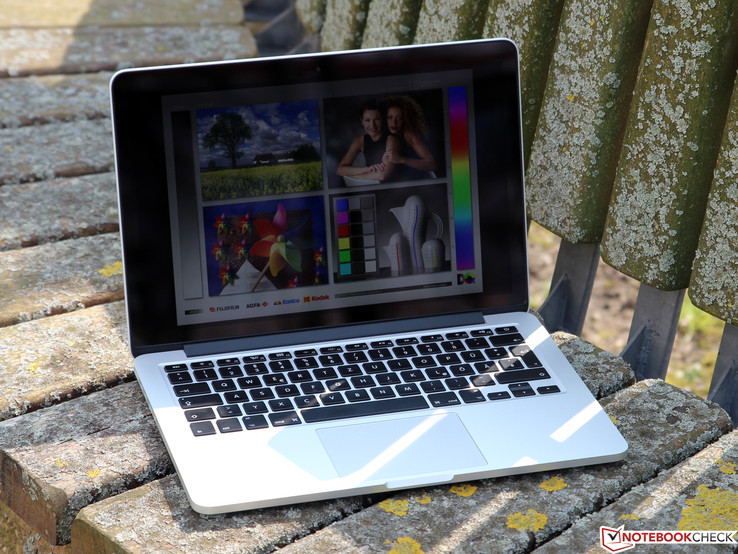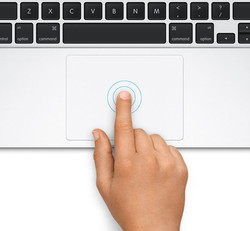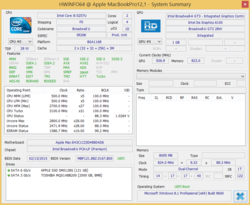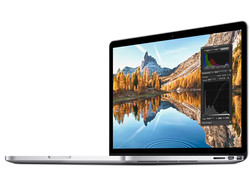Apple MacBook Pro Retina 13 (Early 2015) First Impressions

For the original German preview, see here.
Is there anything more difficult than creating the near-perfect laptop in the notebook industry? Well, I think so. That is keeping the highest standard of a successful product stable over many years, and even improving it slightly in the course of every revision. However, not only Apple, but other manufacturers also struggle with a similar balancing act with their flagship products. Nevertheless, other manufacturers have the advantage that the whole world does not observe the launch of a new or let us say "reworked" or even better "revamped" product like a hawk, and ultimately comment on it. This probably explains - let us call it - Apple's "conservative" laptop development policy. It is also probably due to financial reasons that after about two and a half years, we are once again facing a virtually identical looking Apple device.
Configuration Options
| CPU | RAM | SSD | |
|---|---|---|---|
| Basis (1449 Euros) | Intel Core i5 5257U 2.7 GHz | 8 GB 1866 MHz LPDDR3 SDRAM | 128 GB PCIe flash memory |
| Upgrades | Intel Core i5 5287U 2.9 Ghz (+ 100 Euros) | 16 GB 1866 MHz LPDDR3 SDRAM (+ 200 Euros) | 256 GB PCIe flash memory (+ 200 Euros) |
| Intel Core i7 5557U 3.1 GHz (+ 350 Euros) | 512 GB PCIe flash memory (+ 550 Euros) | ||
| 1 TB PCIe flash memory (+ 1050 Euros) |
While we wait for the in-depth review of the entry-level configuration of the MacBook Retina 13-inch we can share this much. The buyer gets an Intel i5-5257U Broadwell CPU with an Intel Iris Graphics 6100, 8 GB of working memory, and a 128 GB solid-state drive in a PCIe interface for 1449 Euros (~$1574). An Intel i7-5557U with up to 3.4 GHz, up to 16 GB of working memory and up to 1 TB (terabyte) SSD are optionally available, which would push the total price to skyrocket as is typical for Apple. The top-of-the-line configuration of the MacBook Pro 13" 2015 featuring Retina costs an exorbitant 2949 Euros (~$3203), from Apple's German online store at the time of writing this article.
First Impressions
We find a well-known and established device on the table. The looks of the latest MacBook Pro 13 Retina revision corresponds to its precursor (in review here). As before, the build quality, feel and design of the aluminum unibody chassis sets the standards in the laptop sector. Once again, Apple relies more on quality than quantity in terms of interfaces. The user has to be satisfied with two USB 3.0 ports, two Thunderbolt ports that can also be used as a display port (now apparently also with 4K60 support), and an HDMI port. However, the diversity of interfaces seems almost luxurious compared with the Air series.
The installed Broadcom Wi-Fi module also delivered good results, but only after updating the firmware of our 802.1ac TP-Link router. We could transmit up to 65 Mbps via the wireless module in our test setup.
Force Touch Trackpad
Changing a well-liked aspect of a laptop as important as the keyboard and touchpad demands consideration from brand-loyal users. Still, Apple would not be Apple if they did not try to raise the already high bar. The new Force Touch touchpad is no longer suspended mechanically, and the touchpad is incorporated almost firmly in the casing. At least, so it seems when trying to trigger a click when the device is shut down. Pressure on the touchpad produces a haptic feedback that, in our opinion, almost perfectly emulates a conventional, mechanical click. The advantage: The feedback is consistent over the touchpad's entire area, the responsiveness and feedback can be adapted to the user's preferences, and there are no mechanical parts that might be a source of errors during intense use.
This sounds familiar? Right, HP has been using a ForcePad in its Folio 1040 for some time now.
Display
At the time of its launch over two years ago, the "Retina" screen was virtually unmatched. Now there are quite a few devices in a comparable format that also use high-resolution screens. However, the screen installed here is still one of the best in its category. According to our assessments, the current screen is identical to the ones in the preceding models, considering minor measuring inaccuracies and production tolerances.
| |||||||||||||||||||||||||
Brightness Distribution: 81 %
Center on Battery: 360 cd/m²
Contrast: 1000:1 (Black: 0.361 cd/m²)
ΔE ColorChecker Calman: 1.82 | ∀{0.5-29.43 Ø4.82}
ΔE Greyscale Calman: 1.8 | ∀{0.09-98 Ø5.1}
96.9% sRGB (Argyll 1.6.3 3D)
61.9% AdobeRGB 1998 (Argyll 1.6.3 3D)
67.4% AdobeRGB 1998 (Argyll 3D)
97% sRGB (Argyll 3D)
65.9% Display P3 (Argyll 3D)
Gamma: 2.49
CCT: 6417 K
| Apple MacBook Pro Retina 13 inch 2015-03 Iris Graphics 6100, 5257U, Apple SSD SM0128G | Apple MacBook Air 11 inch 2013-06 MD711D/A HD Graphics 5000, 4250U, Apple SSD SM0128F | Apple MacBook Air 13 MD761D/B 2014-06 HD Graphics 5000, 4260U, Apple SSD SD0256F | Apple MacBook Pro Retina 13 inch 2013-10 Iris Graphics 5100, 4258U, Apple SSD SM0256F | Apple MacBook Pro Retina 15 inch 2013-10 GeForce GT 750M, 4850HQ, Apple SSD SM0512F | |
|---|---|---|---|---|---|
| Display | -45% | ||||
| Display P3 Coverage | 65.9 | 35.63 -46% | |||
| sRGB Coverage | 97 | 53.2 -45% | |||
| AdobeRGB 1998 Coverage | 67.4 | 36.87 -45% | |||
| Response Times | |||||
| Response Time Grey 50% / Grey 80% * | 33 ? | ||||
| Response Time Black / White * | 26.2 ? | ||||
| PWM Frequency | |||||
| Screen | -91% | -8% | -11% | -5% | |
| Brightness middle | 361 | 357 -1% | 280 -22% | 327 -9% | 332 -8% |
| Brightness | 342 | 329 -4% | 263 -23% | 300 -12% | 302 -12% |
| Brightness Distribution | 81 | 85 5% | 84 4% | 84 4% | 83 2% |
| Black Level * | 0.361 | 0.59 -63% | 0.32 11% | 0.42 -16% | 0.3326 8% |
| Contrast | 1000 | 605 -39% | 875 -12% | 779 -22% | 998 0% |
| Colorchecker dE 2000 * | 1.82 | 6.92 -280% | 1.91 -5% | 1.95 -7% | |
| Colorchecker dE 2000 max. * | 3.26 | ||||
| Greyscale dE 2000 * | 1.8 | 7.26 -303% | 2 -11% | 2.11 -17% | |
| Gamma | 2.49 88% | 2.4 92% | 2.26 97% | 2.34 94% | |
| CCT | 6417 101% | 9456 69% | 6724 97% | 6489 100% | |
| Color Space (Percent of AdobeRGB 1998) | 61.9 | 35 -43% | 60.6 -2% | ||
| Color Space (Percent of sRGB) | 96.9 | ||||
| Total Average (Program / Settings) | -68% /
-79% | -8% /
-8% | -11% /
-11% | -5% /
-5% |
* ... smaller is better
Performance
The main reason for this refresh is found inside the device. To be more precise, it is in the form of the installed Intel Broadwell processors. However, as is familiar from the preceding models, Apple does not use chips from the "standard" range, i.e. Broadwell Core U-series processors with a TDP of 15 watts as found in most Windows models. Instead, it relies on the tweaked 28-watt models. They differ from their peers, with higher clock rates in terms of base speed and Turbo and considerably stronger Intel Iris Graphics 6100 graphics unit. The latter is capable of providing up to twice the performance power compared to the HD 5500 in the 15-watt models.
We could observe a CPU performance gain of approximately 19% to 23% (single thread, multithread) over the Intel i5-4258U Haswell processor used in the precursor. Therefore, it is comparable with the performance of Intel's i5-4200U CPU (TDP: 47 watts). Intel's current i5-5300U (TDP: 15 watts) lags behind by 6 to 20% depending on the test.
In the OpenGL test, representing the system's graphics performance, the present solution has an edge of roughly 64% over the Iris Graphics 5100 in the precursor. Intel's HD Graphics 5500 in the ThinkPad X1 Carbon is outperformed by approximately 20%.
Not only the CPU, but also the installed storage that is now based on the PCIe interface has been modified in the user's interest. We observed an increase of 5 to 100% in the read and write rates compared with the SSD solution in the precursor in the CrystalDiskMark benchmark test.
| Apple MacBook Pro Retina 13 inch 2015-03 Iris Graphics 6100, 5257U, Apple SSD SM0128G | Apple MacBook Pro Retina 13 inch 2013-10 Iris Graphics 5100, 4258U, Apple SSD SM0256F | Lenovo ThinkPad X1 Carbon 2015 HD Graphics 5500, 5300U, Samsung SSD PM851 256 GB MZNTE256HMHP | Dell XPS 13 9343 Core i7 HD Graphics 5500, 5500U, Samsung SSD PM851 M.2 2280 256GB | |
|---|---|---|---|---|
| CrystalDiskMark 3.0 | -22% | 9% | 3% | |
| Read Seq | 1403 | 705 -50% | 524 -63% | 527 -62% |
| Write Seq | 657 | 634 -4% | 246 -63% | 237.2 -64% |
| Read 512 | 810 | 461 -43% | 432.4 -47% | 420.5 -48% |
| Write 512 | 648 | 571 -12% | 246 -62% | 241.6 -63% |
| Read 4k | 20.95 | 17.4 -17% | 36.17 73% | 28.29 35% |
| Write 4k | 32.43 | 30.9 -5% | 103.1 218% | 103.7 220% |
Emissions
Temperature
As far as we can judge at this stage of our tests, the surface temperatures have not increased significantly despite the higher performance. We can also give the all clear signal for the MacBook Pro Retina 13-inch's system noise. The device remains virtually silent when used without significant load. Only during permanent load does the cooling system speed up to an audible level. As in the precursors, this happens slowly and without any abrupt fan speed changes, in an unproblematic frequency range.
(-) The maximum temperature on the upper side is 45.1 °C / 113 F, compared to the average of 35.9 °C / 97 F, ranging from 21.4 to 59 °C for the class Subnotebook.
(+) The bottom heats up to a maximum of 39.6 °C / 103 F, compared to the average of 39.3 °C / 103 F
(+) In idle usage, the average temperature for the upper side is 27.7 °C / 82 F, compared to the device average of 30.8 °C / 87 F.
(+) The palmrests and touchpad are cooler than skin temperature with a maximum of 31 °C / 87.8 F and are therefore cool to the touch.
(-) The average temperature of the palmrest area of similar devices was 28.2 °C / 82.8 F (-2.8 °C / -5 F).
Battery Life
Apple has now managed to slightly increase the capacity of the installed battery to 74.9 Wh. In our video playback tests (Big Buck Bunny H.264 1080p), the observed runtime of 7 hours 47 minutes increased to 9 hours 41 minutes. This equates to an increase of approximately two hours or 24% in a real-life scenario.
Preliminary Verdict
As far as we can judge at this stage of our tests, we would conclude with "mission accomplished" for now.
A good device could be improved even a little more.
A small technical sophistication has flowed into the otherwise nondescript technology update in the form of the new Force Touch touchpad. We remain curious as to how Apple's fan community will accept the touchpad. Attempts to establish a Force Touch touchpad in the Windows World has not exactly found much media interest until now (e.g. in HP Folio 1040).
We will deal with all innovations in detail in the framework of our soon to follow in-depth review of the MacBook Pro Retina 13-inch (2015).
















